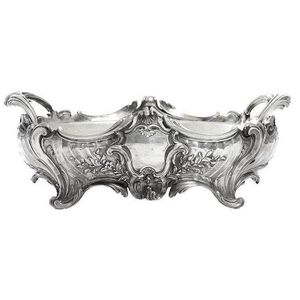Christofle Silver Plated Jardiniere with Liner
You must be a subscriber, and be logged in to view price and dealer details.
Subscribe Now to view actual auction price for this item
When you subscribe, you have the option of setting the currency in which to display prices to $Au, $US, $NZ or Stg.
- Foliate - Decorated with leaves or leaf-like forms.
- Cartouche - An ornamental panel in the form of of a shield, oval or rectangular scroll with curling edges. It may be carved into the back of a chair or the top of a sideboard, or present on a piece of silver or jewellery, and contain the initials of the original owner, heraldic symbols, or some other inscription, such as the details of a presentation.
In ceramics the term defines the central area of a vase or similar with a decorative border in one of the shapes above, into which a decorative scene or figures have been painted. - Bronze - An alloy of copper and tin, traditionally in the proportions of about 9 parts of copper to 1 part of tin.
The discovery of bronze in Western Asia in the 4th century enabled people to create metal objects which were superior to those previoulsy possible because of its strength and hardness, and it has been used throughout the world for weapons, coins, tools, statuary and other decorative items.
It is very fluid in a molten state, and its hardness, strength when set, and non-corrosive properties makes it most suitable for casting sculpture. - Belle Epoque - The Belle Époque, also known as the "Beautiful Era," was a period in European history that lasted from the late 19th century to the outbreak of World War I in 1914. The term is most commonly associated with France, but is also used to refer to the same period in other countries, particularly in Western Europe and Latin America.
During the Belle Époque, Europe experienced a time of great prosperity and cultural, artistic, and scientific advancements. It was an era of peace and optimism, characterized by industrial growth, urbanization, and new technologies such as electricity, automobiles, and the telephone. The period is also associated with a flourishing of art and culture, particularly in the fields of literature, music, and the visual arts.
This item has been included into following indexes:
Visually similar items

A Victorian sterling silver three piece silver tea service, maker's mark Samuel Hayne & Dudley Carter / London, circa 1848-1849, comprising a teapot, a sugar vessel and a creamer, each with a lobed body, 1442grs. Total weight, the teapot 19 cm high

German (830) silver coffee set. Coffee pot 25 cm

A William IV silver cream jug, fluted pear shape raised on four acanthus scroll feet. London 1836/37 by John & Henry Lias. 195gms.

A German silver (800) tea & coffee service [4], includes teapot, coffee pot, sugar bowl & creamer, Wt.1382 grams
